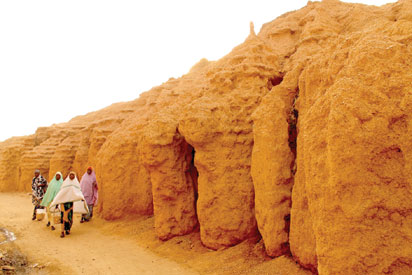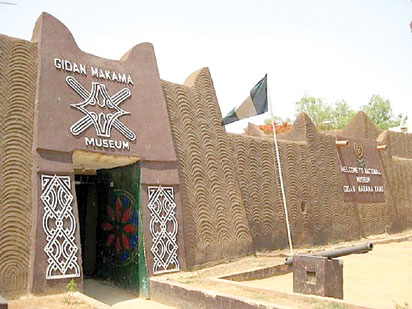By Jimoh Babatunde
The National Commission for Museums and Monuments (NCMM) recently requested the permission of the Kano State Emirate to establish an Islamic art museum at the defunct British Council’s premises in Kano. The building housing the British Council Building located near Gidan Makama is said to be about 400 years old and was once used by a former emir of Kano, Muhammadu Rumfa. NCMM said they have also selected five more sites in the state for inclusion in the list of additional national monuments. Here are some of selected tourist sites in Kano.
GIDAN Makama House: Gidan Makama House, once served as the palace of the emir of Kano but now houses a museum with wide spectrum and array of art, craft and artifact representing the history, political and religious heritage of the people.
The museum walks you through Kano history from the 9th to 21st century. The museum takes about 45 minutes to an hour to get through. The jihad period and the British invasion of the city in 1901 are really interesting. Another overlooked building is Gidan Dan Hausa, which is the Kano State museum.
Gidan Dan Hausa house has a collection of artifacts from stone age to present day. Gidan Rumfa: This is what the present palace of the emir is known by and it is an enchanting edifice on expansive landscape. Historically, the palace was built during the reign of Emir Muhammadu Rumfa in the 13th Century. It is a vast complex and rich in splendour with a touch of aristocracy. It houses different sections and facilities as well as a mosque.
Kano City Wall/Gates: The city walls and gates are landmarks that open a window to the past existence of the people. Although the original outlook of most of the city walls have been destroyed what now stand are replicas of the preserved walls. This ancient city wall with a 14km radius earth structure was completed in 14th Century to provide security to the growing population of the old Kano city in the wake of any external aggression.
Numbering about 15, the city walls once served as defensive facilities with gate and also demarcated the abode of the indigenes from those of the strangers. The surviving city walls include those located at the Bayero University old campus road; where you come across Sabuwar Kofar, Dan Agundi, Kabuga, Dukawuya and Gadon Kaya. Other sites are Goron hill and Kofar Ruwa while that of Kofar Nasarawa road presents a picture of the renovated wall.
Dala hills: It is one where the first inhabitants of the city settled. Traces of this historical fact are evident as you meander through the area where many of the buildings still retain their rural appeal. Standing atop Dala hill affords one a bird eye’s view of the sprawling city.
Conducive place for tourists
It is a good location for picnic; relaxation and photo shoot with the condition greatly improved over the years to make it conducive place for tourists. At the bottom of the hill is a complex for shopping and other activities.
The last time I was there, the complex was yet to be completed but it is hoped that it would have been made over by now so as to give visitors something to cherish at the centre. Besides Dala Hill, there are other historical sites that give better perspective to the city’s landscape as well. Some of these include Goron Dutse, which is about two kilometers walk from Dala Hill. Others are Magwan in Nasarawa area, Panisau around the Kano airport and the famous Bompai. Accessing them is very easy as there are inbuilt stairways from the base to the top.
Kano Dying Pit: Is one of the renowned spots in the city to watch local artisans at work as they turn out clothe materials of different designs from the dying pit, which is believed to be as one as the city itself.
Various designs are folded into the material before dyeing and the fabric is often beaten to achieve the shiny, indecent appearance.
Works of art on fabric
The techniques employed to obtain the look are unmatched around the world. And, although the methods they use are ancient, these lush works of art on fabric always.
remain extremely popular and continue to be in great demand.
Kurmi Market : Located within the city centre, it remains one of the commercial nerve centres of the city, which over the years was famed for Trans – Sahara trade.
Famed as one of Africa’s oldest market, Kurmi market is an expansive market that a visitor would find intriguing exploring.
The market is a maze of narrow alleys where tourists can find pretty much anything, shop for everything from carvings, calabashes, to jewelery, brass works, leather goods and pottery.
Kano Central Mosque: Located in the emir’s palace vicinity is Kano Central Mosque, which is another captivating landmark of the city. Built around the 15th Century, it has over the years undergone different phases of re-engineering. It has a masterpiece architectural design and facade with a blend of Arabic flavour.
Tiga Dam/Rock Castle: Tiga dam is one of the biggest creations in Kano state. Located outside of the city, it is one of the tourist sites with an attractive ambiance. Boat cruise and spot fishing are some of the water related activities that anyone visiting can enjoy. At the base of the dam is Rock Castle Hotel, which was built in the heydays of the state to house Queen Elizabeth and her entourage during her visit to Nigeria years back.
- See more at: http://www.vanguardngr.com/2015/01/kano-tourist-attractions-make-national-monument-list-2/#sthash.fqTKESRA.dpuf
The National Commission for Museums and Monuments (NCMM) recently requested the permission of the Kano State Emirate to establish an Islamic art museum at the defunct British Council’s premises in Kano. The building housing the British Council Building located near Gidan Makama is said to be about 400 years old and was once used by a former emir of Kano, Muhammadu Rumfa. NCMM said they have also selected five more sites in the state for inclusion in the list of additional national monuments. Here are some of selected tourist sites in Kano.
GIDAN Makama House: Gidan Makama House, once served as the palace of the emir of Kano but now houses a museum with wide spectrum and array of art, craft and artifact representing the history, political and religious heritage of the people.
 |
| Kano City wall |
The museum walks you through Kano history from the 9th to 21st century. The museum takes about 45 minutes to an hour to get through. The jihad period and the British invasion of the city in 1901 are really interesting. Another overlooked building is Gidan Dan Hausa, which is the Kano State museum.
Gidan Dan Hausa house has a collection of artifacts from stone age to present day. Gidan Rumfa: This is what the present palace of the emir is known by and it is an enchanting edifice on expansive landscape. Historically, the palace was built during the reign of Emir Muhammadu Rumfa in the 13th Century. It is a vast complex and rich in splendour with a touch of aristocracy. It houses different sections and facilities as well as a mosque.
Kano City Wall/Gates: The city walls and gates are landmarks that open a window to the past existence of the people. Although the original outlook of most of the city walls have been destroyed what now stand are replicas of the preserved walls. This ancient city wall with a 14km radius earth structure was completed in 14th Century to provide security to the growing population of the old Kano city in the wake of any external aggression.
 |
| Gidan Makam Museum |
Numbering about 15, the city walls once served as defensive facilities with gate and also demarcated the abode of the indigenes from those of the strangers. The surviving city walls include those located at the Bayero University old campus road; where you come across Sabuwar Kofar, Dan Agundi, Kabuga, Dukawuya and Gadon Kaya. Other sites are Goron hill and Kofar Ruwa while that of Kofar Nasarawa road presents a picture of the renovated wall.
Dala hills: It is one where the first inhabitants of the city settled. Traces of this historical fact are evident as you meander through the area where many of the buildings still retain their rural appeal. Standing atop Dala hill affords one a bird eye’s view of the sprawling city.
Conducive place for tourists
It is a good location for picnic; relaxation and photo shoot with the condition greatly improved over the years to make it conducive place for tourists. At the bottom of the hill is a complex for shopping and other activities.
The last time I was there, the complex was yet to be completed but it is hoped that it would have been made over by now so as to give visitors something to cherish at the centre. Besides Dala Hill, there are other historical sites that give better perspective to the city’s landscape as well. Some of these include Goron Dutse, which is about two kilometers walk from Dala Hill. Others are Magwan in Nasarawa area, Panisau around the Kano airport and the famous Bompai. Accessing them is very easy as there are inbuilt stairways from the base to the top.
Kano Dying Pit: Is one of the renowned spots in the city to watch local artisans at work as they turn out clothe materials of different designs from the dying pit, which is believed to be as one as the city itself.
Various designs are folded into the material before dyeing and the fabric is often beaten to achieve the shiny, indecent appearance.
Works of art on fabric
The techniques employed to obtain the look are unmatched around the world. And, although the methods they use are ancient, these lush works of art on fabric always.
remain extremely popular and continue to be in great demand.
Kurmi Market : Located within the city centre, it remains one of the commercial nerve centres of the city, which over the years was famed for Trans – Sahara trade.
Famed as one of Africa’s oldest market, Kurmi market is an expansive market that a visitor would find intriguing exploring.
The market is a maze of narrow alleys where tourists can find pretty much anything, shop for everything from carvings, calabashes, to jewelery, brass works, leather goods and pottery.
Kano Central Mosque: Located in the emir’s palace vicinity is Kano Central Mosque, which is another captivating landmark of the city. Built around the 15th Century, it has over the years undergone different phases of re-engineering. It has a masterpiece architectural design and facade with a blend of Arabic flavour.
Tiga Dam/Rock Castle: Tiga dam is one of the biggest creations in Kano state. Located outside of the city, it is one of the tourist sites with an attractive ambiance. Boat cruise and spot fishing are some of the water related activities that anyone visiting can enjoy. At the base of the dam is Rock Castle Hotel, which was built in the heydays of the state to house Queen Elizabeth and her entourage during her visit to Nigeria years back.
- See more at: http://www.vanguardngr.com/2015/01/kano-tourist-attractions-make-national-monument-list-2/#sthash.fqTKESRA.dpuf

Never ever visited Kano in my life,. This is a really new place for me and would like to travel with https://www.goldenbustours.com/. I am sure will have an amazing time period there.
ReplyDelete